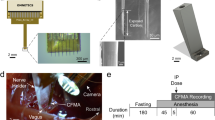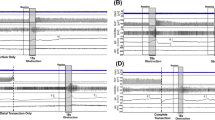Abstract
The vagus nerve carries sensory information from multiple organs in the body. The recording of its activity and further processing is a key step for neuromodulation treatments. This paper presents a specific algorithm for the processing and discrimination of intrafascicular recordings from the vagus nerve using the novel carbon nanotube yarn electrodes. Up to four different neural waveforms were found, whose occurrence corresponded to distinct levels of anesthesia depth.
Similar content being viewed by others
References
LEE S. A mechanistic understanding of vagus nerve stimulation therapy: Investigating the effects of parasympathetic modulation on cardiac dynamics [D]. Minneapolis: University of Minnesota, 2018.
BERTHOUD H R, NEUHUBER W L. Functional and chemical anatomy of the afferent vagal system [J]. Autonomic Neuroscience, 2000, 85(1/2/3):1–17.
GUIRAUD D, ANDREU D, BONNET S, et al. Vagus nerve stimulation: State of the art of stimulation and recording strategies to address autonomic function neuromodulation [J]. Journal of Neural Engineering, 2016, 13(4):041002.
HANDFORTH A, DEGIORGIO C M, SCHACHTER S C, et al. Vagus nerve stimulation therapy for partialonset seizures: A randomized active-control trial [J]. Neurology, 1998, 51(1):48–55.
ELLIOTT R E, MORSI A, KALHORN S P, et al. Vagus nerve stimulation in 436 consecutive patients with treatment-resistant epilepsy: Long-term outcomes and predictors of response [J]. Epilepsy & Behavior, 2011, 20(1):57–63.
MASI E B, LEVY T, TSAAVA T, et al. Identification of hypoglycemia-specific neural signals by decoding murine vagus nerve activity [J]. Bioelectronic Medicine, 2019, 5(1): 9.
ZANOS T P, SILVERMAN H A, LEVY T, et al. Identification of cytokine-specific sensory neural signals by decoding murine vagus nerve activity [J]. Proceedings of the National Academy of Sciences of the United States of America, 2018, 115(21): E4843–E4852.
WODLINGER B, DURAND D M. Localization and recovery of peripheral neural sources with beamforming algorithms [J]. IEEE Transactions on Neural Systems and Rehabilitation Engineering, 2009, 17(5):461–468.
ZHU F, ZHU J, ZHANG X, et al. Flexural characterization of carbon nanotube (CNT) yarn neural electrodes [J]. Materials Research Express, 2019, 6(4):045402.
MCCALLUM G A, SUI X, QIU C, et al. Chronic interfacing with the autonomic nervous system using carbon nanotube (CNT) yarn electrodes [J]. Scientific Reports, 2017, 7: 11723.
VITALE F, SUMMERSON S R, AAZHANG B, et al. Neural stimulation and recording with bidirectional, soft carbon nanotube fiber microelectrodes [J]. ACS Nano, 2015, 9(4):4465–4474.
YU X, SU J Y, GUO J Y, et al. Spatiotemporal characteristics of neural activity in tibial nerves with carbon nanotube yarn electrodes [J]. Journal of Neuroscience Methods, 2019, 328: 108450.
SU J Y, ZHANG X, LI M N, et al. Insulation of carbon nanotube yarn electrodes for intrafascicular neural stimulation and recording [C]//2019 9th International IEEE/EMBS Conference on Neural Engineering. San Francisco, CA, USA: IEEE, 2019: 815–818.
TOADER E, CIVIDJIAN A, QUINTIN L. Isoflurane suppresses central cardiac parasympathetic activity in rats: a pilot study [J]. Minerva Anestesiologica, 2011, 77(2):142–146.
SKOVSTED P, SAPTHAVICHAIKUL S. The effects of isoflurane on arterial pressure, pulse rate, autonomic nervous activity, and barostatic reflexes [J]. Canadian Anesthetists’ Society Journal, 1977, 24(3):304–314.
STEFFEY E P, MAMA K R, BROSNAN R J. Inhalation anesthetics [M]//GRIMM K A, LAMONT L A, TRANQUILLI W J, et al. Veterinary anesthesia and analgesia: The fifth edition of Lumb and Jones’. Ames, IA, USA: John Wiley & Sons, Inc., 2017: 297–331.
LIEB F, STARK H G, THIELEMANN C. A stationary wavelet transform and a time-frequency based spike detection algorithm for extracellular recorded data [J]. Journal of Neural Engineering, 2017, 14(3):036013.
NASON G P, SILVERMAN B W. The stationary wavelet transform and some statistical applications [M]//ANTONIADIS A, OPPENHEIM G. Wavelets and statistics. New York, NY, USA: Springer, 1995: 281–299.
KAISER J F. Some useful properties of Teager’s energy operators [C]//1993 IEEE International Conference on Acoustics, Speech, and Signal Processing. Minneapolis, MN, USA: IEEE, 1993: 149–152.
VAN DER MAATEN L, HINTON G. Visualizing data using t-SNE [J]. Journal of Machine Learning Research, 2008, 9: 2579–2605.
ESTER M, KRIEGEL H P, SANDER J, et al. A density-based algorithm for discovering clusters in large spatial databases with noise [C]//Second International Conference on Knowledge Discovery and Data Mining. Portland, OR, USA: AAAI, 1996: 226–231.
NATORA M, OBEMAYER K. An unsupervised and drift-adaptive spike detection algorithm based on hybrid blind beamforming [J]. EURASIP Journal on Advances in Signal Processing, 2011, 2011: 696741.
HUDSON A E, HEROLD K F, HEMMINGS H C. Pharmacology of inhaled anesthetics [M]//HEMMINGS H C, EGAN T D. Pharmacology and physiology for anesthesia. Philadelphia, PA, USA: Elsevier, 2019: 217–240.
DALE O, BROWN B R. Clinical pharmacokinetics of the inhalational anaesthetics [J]. Clinical Pharmacokinetics, 1987, 12(3):145–167.
CHAURE F J, REY H G, QUIROGA R Q. A novel and fully automatic spike-sorting implementation with variable number of features [J]. Journal of Neurophysiology, 2018, 120(4):1859–1871.
Acknowledgment
The authors would like to thank Prof. D.M. Durand for guidance of CNT yarn electrode fabrication, Y.T. Zhang for advice on vagal activity recording, Prof. Y. Chen from visual function restoration and rehabilitation laboratory for support, Mr. C.M. Yang and Ms. Y. Chen from Suzhou for help in PC insulation, J.Y. Su for helping with the surgery.
Author information
Authors and Affiliations
Corresponding author
Additional information
Foundation item: the National Natural Science Foundation of China (No. 81671801), the Medical-Engineering Cross Project of Shanghai Jiao Tong University (No. YG2017MS53), and the Innovation Studio from School of Biomedical Engineering, Shanghai Jiao Tong University
Rights and permissions
About this article
Cite this article
Arranz, J., Guo, J., Yu, X. et al. Intrafascicular Vagal Activity Recording and Analysis Based on Carbon Nanotube Yarn Electrodes. J. Shanghai Jiaotong Univ. (Sci.) 25, 447–452 (2020). https://doi.org/10.1007/s12204-020-2197-9
Received:
Published:
Issue Date:
DOI: https://doi.org/10.1007/s12204-020-2197-9




